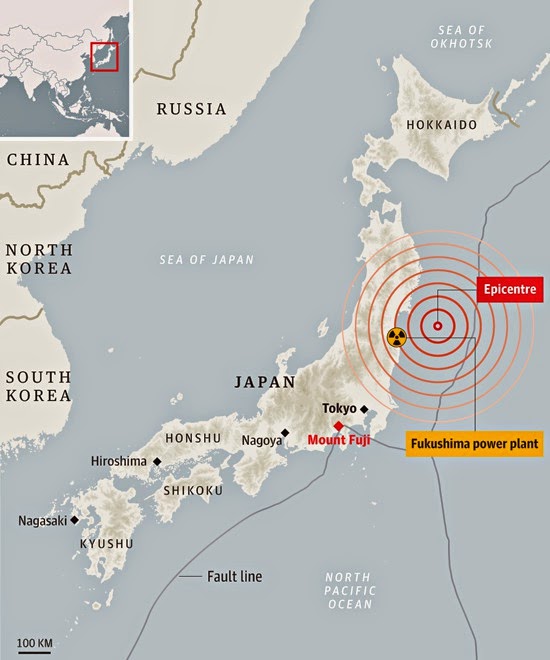
Mount Fuji, or Fujisan as it is known in Japanese, is the highest point on the archipelago (rising to 3,776 metres) and the national emblem, immortalised in countless etchings. In June last year Unesco added it to the World Heritage list as a “sacred place and source of artistic inspiration”. But it is still an active volcano, standing at the junction between the Pacific, Eurasian and Philippine tectonic plates. Though it has rarely stirred in recorded history, it is still potentially explosive.
The Tohoku – or Great East Japan – earthquake on 11 March 2011 triggered a devastating tsunami, which in turn caused the Fukushima Daiichi nuclear disaster. According to a Franco-Japanese study published by Science (PDF), the magnitude-9 tremor also increased the pressure on Mount Fuji. “Our work does not say that the volcano will start erupting, but it does show that it’s in a critical state,” says Florent Brenguier, a researcher at the Institute of Earth Sciences (IST) in Grenoble, France, and lead author of the publication, to which the Institute of Global Physics (IPG) in Paris also contributed.
Adopting a novel approach, the scientists carried out a sort of giant echo-scan of the bowels of the Earth, based on the huge mass of data recorded after the mega-quake by Japan’s Hi-net system, the densest network in the world, with 800 seismic sensors. They focused on signals commonly known as seismic noise, the result of constant interaction between ocean swell and “solid” earth. In the past such data has generally been dismissed as background interference.
By recording fluctuations in this barely perceptible subterranean noise they were able to map geological disturbances in the bedrock of Japan caused by the seismic waves following the violent quake in March 2011. “Seismic waves travel a very long way, going round the world several times,” Brenguier explains. “Their movement makes the Earth’s crust vibrate, and rather like a shock wave this produces breaks or cracks in the rock.”
One might well imagine that such disturbance is greatest close to the epicentre of a quake, but this is not the case. The Franco-Japanese study shows that the area where the Earth’s crust suffered the greatest damage was not around Tohoku, in the north-east of Honshu island, but in the volcanic regions, in particular under Mount Fuji, some 400km away. “The volcanic regions are the ones where the fluids trapped in the rock – boiling water, gas, liquid magma, which cause an eruption when they rise to the surface – exert the greatest pressure. The seismic waves add to this pressure, causing even more disturbance,” Brenguier says.
The magnitude 6.4 quake that occurred four days after the tsunami, followed by many smaller aftershocks, was a further indication that Mount Fuji is under high pressure.
So should Japan be on red alert? “We cannot establish a direct relation of cause and effect between quakes and volcanic eruptions, even if statistically the former lead to an increase in the latter,” Brenguier says. “All we can say is that Mount Fuji is now in a state of pressure, which means it displays a high potential for eruption. The risk is clearly higher.”
Science, however, has no way of predicting when this might happen. But there is a precedent. The last eruption of Mount Fuji occurred in 1707. It projected almost a billion cubic metres of ash and debris into the atmosphere, some of which reached Tokyo (then called Edo) 100km away. It was preceded, 49 days earlier, by a magnitude 8.7 quake to the south of Japan that, in conjunction with the tidal wave it raised, claimed more than 5,000 lives. This time, more than three years have already passed since the Tohoku quake. But that does not mean that Mount Fuji, under the constant supervision of Japanese geologists, is slumbering.
Come what may, the method developed by the Franco-Japanese team for investigating volcanic areas should improve the accuracy of efforts all over the world to assess the risk of major volcanic eruptions.
This story appeared in Guardian Weekly, which incorporates material from Le Monde
Note : The above story is based on materials provided by Pierre Le Hir “Guardian Weekly”










